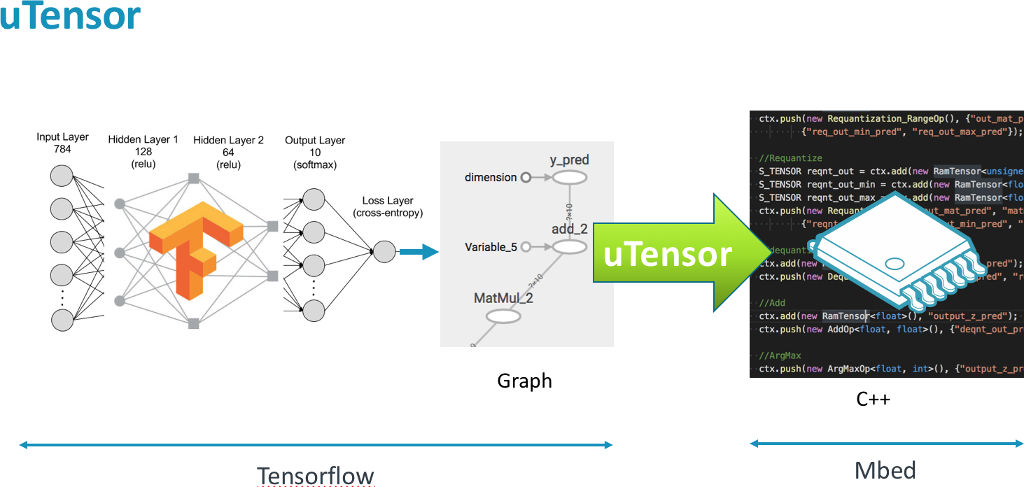Model Serialization: Lesson Learnt from Tensorflow 1.x and 2.x¶
.... And Why I'm So Fucked by Tensorflow
uTensor

utensor_cgen: code generator foruTensor
Model Development and Deployment¶
- define the graph
- training the graph
- graph transformation: graph rewriting, including quantization, node fusion, node removal, etc.
- saving the graph: model serialization
In [2]:
# Tensorflow 1.x
import tensorflow as tf
from tensorflow import import_graph_def
from tensorflow.tools.graph_transforms import TransformGraph
print(tf.__version__)
graph = tf.Graph()
with graph.as_default():
with tf.gfile.GFile("simple_model.pb", "rb") as fid:
graph_def = tf.GraphDef()
graph_def.ParseFromString(fid.read())
out_tensor, = import_graph_def(
graph_def,
return_elements=["y_pred:0"]
)
out_tensor
1.13.0-rc1
Out[2]:
<tf.Tensor 'import/y_pred:0' shape=(10,) dtype=int64>
float model

In [3]:
# Quantization in Tensorflow 1.x
quant_graph_def = TransformGraph(
graph_def,
inputs=[],
outputs=["y_pred"],
transforms=["quantize_weights", "quantize_nodes"]
)
with open('quant_simple_model.pb', 'wb') as fid:
fid.write(quant_graph_def.SerializeToString())
quantized model

dynamic quantization

In [1]:
import tensorflow as tf
print(tf.__version__)
2.3.1
In [ ]:
# Tensorflow 2.x: Tensorflow Lite
model = ... # A tensorflow.keras.Model instance, **trained**
model.save('model_path') # save model, normal keras save/load api
# trainable graph -> constant graph in TF 2.x
from tensorflow.python.framework.convert_to_constants import convert_variables_to_constants_v2
model_func = tf.function(lambda x: model(x))
model_func = model_func.get_concrete_function(tf.TensorSpec(...)) # setup the input spec
model_func = convert_variables_to_constants_v2(model_func, lower_control_flow=False)
# save the freezed graph as pb file
with open('const_graph.pb', 'wb') as fid:
fid.write(model_func.graph.as_graph_def().SerializeToString())
# create a converter which will convert a keras model to tflite flatbuffer
converter = tf.lite.TFLiteConverter.from_keras_model(model)
converter.optimizations = [tf.lite.Optimize.DEFAULT]
# represent_ds is an callable which return a generator that will return representative dataset
converter.representative_dataset = represent_ds
In [ ]:
# tflite_buffer are bytes
tflite_buffer = converter.convert()
with open('model.tflite', 'wb') as fid:
fid.write(tflite_buffer)
References
Keras float model

Keras quantized model (TFLite)

Graph Rewriting¶
Implement with isomorphic subgraph matching
Why I'm Sooo Fucked¶

Inconsistent Operation Name¶
- ex:
AddvsQuantizedAddvsAddOp
- Hard to identify the type of an operation/node in the graph
- Hard to implement/test isomorphic subgraph matching
Operation name/type legalization is required
Fused Operation¶
- ex:
MatMul + Add + <activation_func> => FullyConnected
- Hard to define a generic intermediate representation
FullyConnected => MatMul + Add + <activation_func>?MatMul + Add + <activation_func> => FullyConnected?- Which is better and why?
Implementation Differences Across Versions¶
- Take
tf.nn.dropoutas example
Dropout in Tensorflow 1.x¶

Dropout in Tensorflow 2.x¶

Breaking Changes of Frameworks¶
- Changes in quantization scheme
- Dynamic Quantization v.s Static Quantization
- Quantization-Awared Training
- Inconsistent Saving/Loading API
- Undocumented features
Q & A¶

